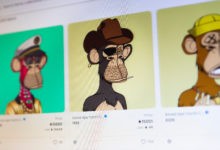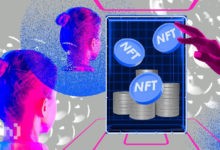Why Meta Matters in NFTs

It would be inaccurate to claim that NFTs creators, collectors and traders don’t care about the value of their assets in dollar terms. However, there is, in part, an NFT outlook by which 1 ETH equals 1 ETH, meaning that NFT prices are tracked in crypto terms, rather than fiat amounts.
This perspective pays a little less attention to short-term crypto prices, preferring to focus on what is being built in the NFT ecosystem, while maintaining an underlying confidence in the long-term future of ETH, and some of the other cryptocurrencies in which NFTs are priced.
A major benefit to this mindset is that it’s more natural to maintain a relatively optimistic sentiment when that sentiment is not bound up with day-to-day price movements. Set free from endless market analysis, it becomes easier for NFT participants to hone in on creativity, art, and tech practicalities.
That last aspect, practicality, may seem counterintuitive, considering that NFTs are often disparaged by observers who haven’t recognized what non-fungible forms of crypto might actually be used for.
However, utility is a constant point of discussion in NFT communities, with constructive debates around how NFTs can provide value, and what kinds of practical facilities they might enable, across sectors.
While crypto prices relating to the underlying blockchain are not always the most upfront part of NFT discussion, something that is sometimes tracked and speculated over more closely is the concept of meta.
Understanding Meta in NFTs
The word meta has, in tech and crypto worlds, come to be associated with metaverse development, and may bring to mind the parent company of Facebook, which famously rebranded itself as Meta in 2021.
However, when it comes to NFTs, which, in true countercultural style, have incubated their own modes of speech and idiosyncratic terminologies, meta has its own distinct meaning. Within this context, meta refers to the concepts, memes and stylistic leanings that are driving the NFT space at any given time.
NFT meta can originate from a single project that becomes influential, and then shifts the direction that incoming new collections begin to take. Certainly, some meta-following newcomers are simple copycats, but, at other times, meta is played with and evolves in interesting ways, as newer collections pick up on what works and improve or adapt it.
There is an advantage to be had, then, in identifying patterns and trends in NFT meta, and picking up early on new pivots and paths before they have fully solidified.
Check out the FMLS22 session on «NFTs for Fintechs: From Asset Class to the Machinery of Ownership.»
NFT Changes from 2021 through 2022
Looking back, 2021 was a game-changing year for NFTs, in which, riding high on bull market exuberance, they crashed through into mainstream awareness, and the NFT space expanded tremendously.
We watched prices soar, and the 10,000 item PFP drop became a mainstay, while apes, punks and pixel art were dominant aesthetics.
In addition, the end of that year saw an explosion of interest in the metaverse, and while metaverse development had been ongoing since before then, it was in 2021 that an understanding of the relationship between NFTs, crypto and a working metaverse started to click beyond those involved in blockchain development.
In 2022, there were stylistic shifts in NFT collections towards Japanese anime themes, while a practical focus on the concept of storytelling became prominent. At the same time, we have witnessed a handful of projects establishing dominance as the major players in the NFT markets.
It also became apparent, particularly towards the end of the year, that NFTs were no longer the preserve of crypto obsessives and digitally-immersed online collectors, as major brands lined up web3 plans.
What Will Continue or Emerge in 2023?
Although NFTs are still a nascent market, there are already several projects that have laid down solid foundations, established high prices that get bought up quickly when they dip, and appear likely to continue driving forwards.
Yuga Labs (the creator of Bored Ape Yacht Club) is currently unassailable as the NFT powerhouse of note, and may heavily influence metaverse innovation, with the assistance of partnered metaverse developer Improbable, over the coming years.
CryptoPunks is the originator of the 10,000 item PFP format, crossed over into the realm of prestige traditional auction houses, and has written itself a place in art history. On top of that, it should be noted that the rights to CryptoPunks were, in March 2022, acquired by Yuga Labs.
After those big hitters, the Azuki project looked to be in a strong position, and through its PBT (Physical Backed Token) developments, it is creating links between the physical and the digital.
This connecting of physical and digital items looks set to be a growing area of interest and could be further driven by traditional brands, based, of course, in the real world, entering the web3 sphere, which means putting a foot into a digital world that incorporates ownership.
Further innovation in 2023 is likely to involve not only Ethereum, but, increasingly, Layer 2 solutions such as Arbitrum and Optimism, and the Polygon sidechain is likely to play a substantial web3 role, as it is already picking up significant developer activity.
When it comes to blockchain gaming, web3 proponents are still waiting for a breakthrough title to convince the skeptics. Whether or not this occurs in 2023 remains a matter of speculation, high-quality games are not produced overnight, but it’s plausible that, over the coming year, we edge closer to a playable release in which gameplay is center stage, while NFTs and crypto add valuable new dimensions.






 Bitcoin
Bitcoin  Ethereum
Ethereum  Tether
Tether  USDC
USDC  TRON
TRON  Dogecoin
Dogecoin  Cardano
Cardano  Bitcoin Cash
Bitcoin Cash  Chainlink
Chainlink  Monero
Monero  Stellar
Stellar  LEO Token
LEO Token  Zcash
Zcash  Litecoin
Litecoin  Hedera
Hedera  Dai
Dai  Cronos
Cronos  Tether Gold
Tether Gold  OKB
OKB  Ethereum Classic
Ethereum Classic  KuCoin
KuCoin  Gate
Gate  Algorand
Algorand  Cosmos Hub
Cosmos Hub  VeChain
VeChain  Dash
Dash  TrueUSD
TrueUSD  Tezos
Tezos  Stacks
Stacks  IOTA
IOTA  Basic Attention
Basic Attention  Theta Network
Theta Network  Decred
Decred  NEO
NEO  Synthetix
Synthetix  Qtum
Qtum  Ravencoin
Ravencoin  0x Protocol
0x Protocol  DigiByte
DigiByte  Zilliqa
Zilliqa  Nano
Nano  Numeraire
Numeraire  Siacoin
Siacoin  Waves
Waves  BUSD
BUSD  Status
Status  Ontology
Ontology  Enjin Coin
Enjin Coin  Pax Dollar
Pax Dollar  Hive
Hive  Lisk
Lisk  Steem
Steem  Huobi
Huobi  NEM
NEM  OMG Network
OMG Network  Bitcoin Gold
Bitcoin Gold  Augur
Augur  Ren
Ren  HUSD
HUSD